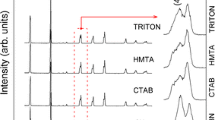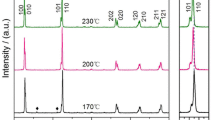Abstract
Lead-free piezoelectric materials have grown in importance through increased environmental concern and subsequent EU and worldwide legislation, with the aspiration to reduce the use of Pb-based materials in all sectors. Integration of the next generation of lead-free piezoelectric materials with substrates to form functional micro devices has received less attention. Low temperature synthesis methods for K0.5Na0.5NbO3 (KNN) powder were developed to overcome the issue of poor purity of the final product during high temperature sintering. Molten hydroxide synthesis (MHS), derived from molten salt synthesis (MSS), has been developed to overcome a Na ion preference in the molten salt synthesis reaction that leads to NaNbO3 production instead of KNN when stoichiometric amounts of precursors are used. MHS makes use of a KOH molten reaction aid in place of the NaCl/KCl molten salt mix of the MSS. In a two stage reaction K rich intermediate niobates are produced and subsequent reactions with Na species produce KNN.





Similar content being viewed by others
References
Rodel J, Jo W, Seifert KTP, Anton EM, Granzow T (2009) J Am Ceram Soc 92(6):1153
Li Y, Wang J, Liao R, Huang D, Jiang X (2010) J Alloys Compd 496:282
Stavber G, Malic B, Kosec M (2011) Green Chem 13:1303
Zeng JT, Kwok KW, Chan HLW (2007) Mater Lett 61:409
Lai F, Li J-F (2007) Ferrroelectrics 358(1):181–187
Yang H, Lin Y, Wang F, Luo H (2008) Mater Manuf Process 23(5):489
Zhang F, Han L, Bai S, Sun T, Karaki T, Adachi M (2008) Jpn J Appl Phys 47(9):7685
Zhang M, Guo M, Zhou Y (2011) Int J Appl Ceram Technol 8(3):591
Yoon HK, Cho YS, Kang DH (1998) J Mater Sci 33:2977. doi:10.1023/A:1004310931643
Kumada N, Ogiso H, Wada S, Yonesaki Y, Takei T, Kinomura N, IIjima T, Watanabe T (2010) J Ceram Soc Jpn 118(1380):738
He J, Comyn TP, Skidmore T, Milne SJ, Bell AJ (2006) Molten-salt synthesis of bismuth titanate and fabrication of PbTiO3-based textured ceramics, ISAF ‘06. In: 15th IEEE international symposium on the applications of ferroelectrics. IEEE, Sunset Beach, pp 49–52
Bortolani F, Dorey R (2010) J Eur Ceram Soc 30(10):2073
Yoon KH, Cho Y-S, Lee D-H, Kang D-H (1993) J Am Ceram Soc 76(5):1373
Malic B, Jenko D, Holc J, Hrovat M, Kosec M (2008) J Am Ceram Soc 91(6):1916
Yi Z, Liu Y, Carpenter MA, Schiemer J, Withers RL (2011) Dalton Trans 40:5066
Santos ICMS, Loureiro LH, Silva MFP, Cavaleiro AMV (2002) Polyhedron 21:2009
Wang Y, Zhiguo Y, Yongxiang L, Yang Q, Wang D (2007) Ceram Int 33:1611
Acknowledgement
The authors acknowledge UK Engineering and the Physical Sciences Research Council (EPSRC) for their support of this study.
Author information
Authors and Affiliations
Corresponding author
Rights and permissions
About this article
Cite this article
Lusiola, T., Bortolani, F., Zhang, Q. et al. Molten hydroxide synthesis as an alternative to molten salt synthesis for producing K0.5Na0.5NbO3 lead free ceramics. J Mater Sci 47, 1938–1942 (2012). https://doi.org/10.1007/s10853-011-5984-8
Received:
Accepted:
Published:
Issue Date:
DOI: https://doi.org/10.1007/s10853-011-5984-8




